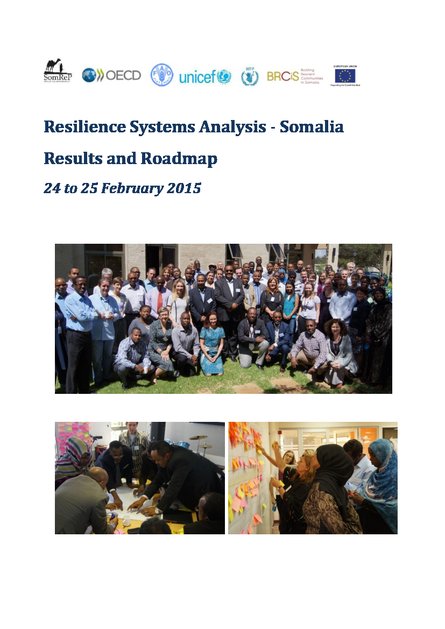
On the 24th and 25th of February 2015, experts in risk and well-being systems, along with key decision makers, met in Nairobi to explore ways to strengthen the resilience of well-being systems of pastoral, agro-pastoral and peri- urban communities in Somalia over the next three to five years.
The meeting was hosted by the Somalia Resilience Program (SomReP) and the Building Resilient Communities in Somalia (BRCiS) consortia, with assistance from the OECD and the active participation of the Ministries of the Federal Government of Somalia, NGOs, civil society, the Red Cross movement, donors and the United Nations. The analysis was structured around the OECD’s resilience systems analysis methodology, drawing on the expertise and knowledge of participants, to develop a concrete set of actions – a ‘roadmap for resilience’. The meeting was generously supported by the European Union, FAO, WFP and UNICEF.
The analysis generated innovative approaches to strengthening the resilience of the target communities and a shared understanding of both the primary risks and the intrinsic stresses within those communities’ systems for well- being. Participants identified nine priority risks including drought, seasonal flooding, livestock disease, human disease and epidemics, the collapse of agricultural markets, conflict and instability, protection issues, and market instability, including price shocks and unfavourable terms of trade. While there was a perception that the risk landscape for Somalia would most likely improve over the next three to five years, there was a sense that this improvement was, nevertheless, fragile and subject to short term interruptions over that time. Key priorities to strengthen the resilience of well-being systems in Somalia included:
Strengthening youth education and technical training programmes
Improving the value chain within key sectors, including fisheries and value-added export processes
Developing a national resource management policy
Strengthening government revenues
Extending community-level early-warning systems
Building basic social infrastructure services
Shifting from humanitarian assistance to social safety nets and long-term development financing
The roadmap to strengthen resilience (starting page 20) shows how different actions to boost resilience in Somalia should be implemented at different layers of society. It necessitates the co-ordinated commitment of a wide range of actors, including the government, private sector, UN agencies and communities themselves, with the commitment of donors. The resilience roadmap will inform a number of key processes in the coming months, including informing planning and strategy processes for the Government of Somalia, the UN, NGOs and civil society. The analysis will also be utilised for the Donor Group meeting for Somalia, scheduled for April 2015 and the OECD’s high level mission for Somalia, led by the Chair of the Donor Assistance Committee, at the end of March 2015.